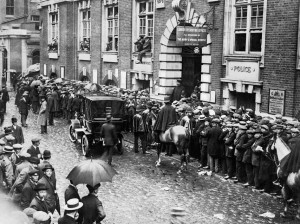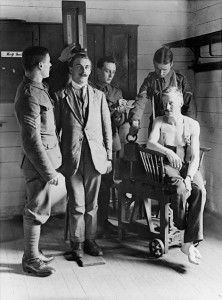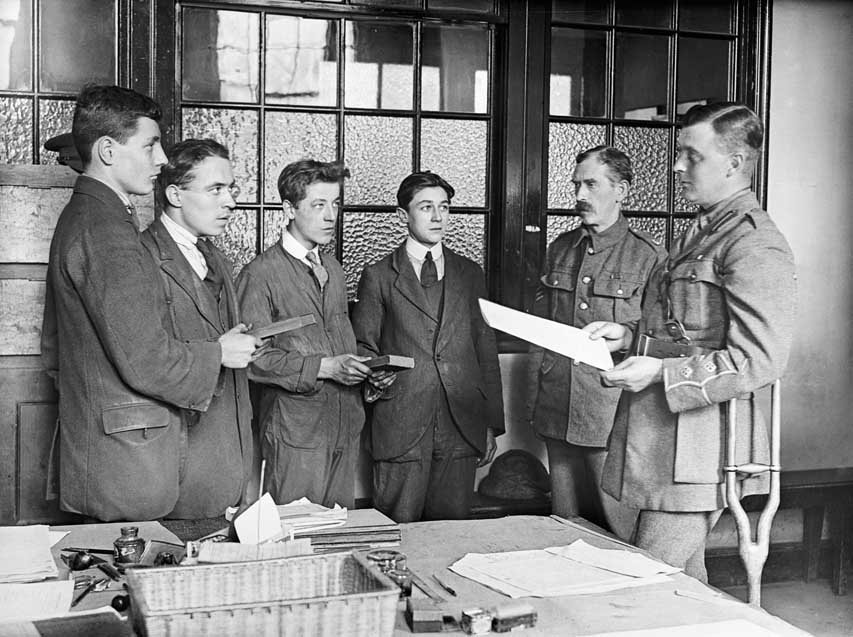Broken soldiers: the chaos of enlistment in the British Army in the early months of the Great War
Published in Features, Issue 2 (March/April 2016), Volume 24, World War I‘THOUSANDS OF MEN WERE PASSED FIT WITHOUT ANY MEDICAL EXAMINATION WORTH THE NAME’
By Michael Robinson

A London recruiting office in 1914. The pre-1914 system of medical screening proved unable to handle the unprecedented rush of recruits in the immediate aftermath of the outbreak of war. (IWM)
During the first seven months of the conflict, recruitment regulations in Ireland and Britain followed those that had been in place prior to the outbreak of the First World War. An army staff member was supposed to undertake a quick review of the potential recruits in order to detect any obvious physical attribute or disability that would necessitate an inspection by a medical officer. The official process of enlistment began with the completion of the attestation form, and the medical examination of the recruit followed. It included, amongst other things, recording the recruit’s height, weight, chest measurement and eyesight. If the recruit’s condition did not present any reason for rejection, he was accepted for active service. The formal process was completed when the recruit pledged an oath of al-legiance to the king whilst holding a Bible in his right hand, after which he received one day’s pay of 1s. 9d.
Pre-war medical screening system continued
The pre-1914 system of medical screening, which was only capable of processing c. 50,000 recruits a year, proved unable to handle the unprecedented rush of recruits in the immediate aftermath of the outbreak of war; 33,204 recruits attested on 3 September 1914 alone, and by the week ending 5 September 174,901 had done so. In Ireland, between 1910 and 1913, enlistment figures annually totalled 2,069, 2,549, 2,756 and 2,655 recruits respectively. Such annual returns were, however, dwarfed by recruiting returns for the first six months of the conflict: 50,107 men enlisted in Ireland between August 1914 and January 1915. Thus Irish participation in the Great War has correctly been described as ‘the greatest deployment of armed manpower in the history of Irish militarism’. There was, however, significant regional variation in Irish recruitment, with Belfast being the most popular recruitment depot by some distance.
Under such conditions, recruitment procedures, which had operated efficiently during peacetime throughout the United Kingdom, broke down. The War Office accepted that the recruitment system struggled to cope during these initial stages:
‘Men, ready and anxious to serve their country, waited for hours, frequently all night, to obtain admission to the recruiting officers, and the machinery for dealing with the vast numbers of recruits proved to be totally inadequate.’
Such was the incredible number of men wanting to enlist during the initial period of the conflict that a ‘considerable number’ of attestation forms were noted by the War Office as being incorrect or incomplete, and some recruiting stations carried on enlisting despite having run out of attestation forms. It was suggested that many recruits with obvious paralysis of limbs and muscles were not detected, and missing fingers and toes were overlooked owing to the fact that there was not enough time to strip a recruit. Such conditions should immediately have disqualified a man from service. One medical officer was even quoted as having a nervous breakdown owing to the unmanageable workload.
Southborough Report
The War Office Committee of Enquiry into Shell Shock, more commonly known as the Southborough Report, published in 1922, also later recognised that the routine recruitment regulations were ignored during the earlier stages of the war. To reach this conclusion, the committee heard the testimony of numerous medical experts whose evidence described the turmoil that accompanied early recruitment procedures. As Major-General W.G. MacPherson disclosed:
‘In the earlier months there was a short period of unrestricted voluntary enlistment, during which there was a wild rush of recruits who swamped the general arrangements’.
This unprecedented situation led Sir James Galloway, a medical inspector of recruiting, to observe that ‘large masses of the male population entered the army with very little medical discrimination’. The chief recruiting staff officer for the London District also alleged that one doctor medically examined 400 men a day for ten consecutive days, believing that such a practice was widespread until September 1915. In his recollection of this initially hectic period, British recruitment officer Coulson Kernahan recalled:
‘As fast as the men came in, they were at that early stage of the war dispatched each to his depot or other appointed place for training’.
Kernahan also described how a recruitment officer often only had time for one meal a day, enduring long shifts without a break into the early hours of the morning. Indeed, with regard to swearing an oath on the Bible, he recalled farcical instances of twelve or more recruits who would ‘hold on with their right hand for dear life to one persecuted Testament while being attested in batches’.

Recruits being weighed and measured. Despite affirmations that physically unsuitable candidates had been ‘rigorously eliminated’ from enlisting in the British Army, a number of men were able to reach the front lines with a physical disability that should have been detected, including those with shortcomings in the requirements of age, height and chest measurements stipulated by the army. (IWM)
Medical officers were not initially paid for a man they rejected but were compensated with one shilling for each recruit that they passed, creating a clear potential for abuse. Subsequent research has contended that they were keen to allow almost every recruit to be accepted as fit for service. The Southborough Report further explored the superficial nature of medical examinations of recruits during this phase, observing that ‘thousands of men were passed fit without any medical examination worth the name’. Thus, despite affirmations that physically unsuitable recruits had been ‘rigorously eliminated’ from enlisting in the British Army, a number of men were able to reach the front lines with a physical disability that should have been detected, included those with shortcomings in the requirements of age, height and chest measurements stipulated by the army. In addition, disabilities such as defective eyesight, varicose veins, bad teeth, hernias, missing toes and fingers, and a variety of physical disabilities were not detected or were purposefully overlooked. There were even ex-amples of men successfully enlisting with wooden feet!
As was the case in Britain, the substandard quality of recruits in Irish units is evident. The diary of the medical officer of the 1st Connaught Rangers records one recruit without teeth who was unable to eat ration biscuits and, instead, had to survive on slop. The medical officer observed that this man was ‘quite unfitted for duties in the field’. He was later killed by rifle fire. Some men were noted to be above the age of 50 and physically unable for trench warfare. Another, suffering from an old wound on the thigh, was unable to march, whilst another recent recruit was noted as having a large hernia on his left side and was sent to a field hospital for treatment. One recruit, unable to straighten his leg in order to get his foot on the ground, was forced to walk on his toes. In his monthly summary of the hospital admissions in July 1915, the medical officer commented on 22 men who, in his opinion, ‘should not have come up to the firing line at all’. Similarly, a 35-year-old recruit who had served six weeks with the Royal Irish Rifles was discharged in October 1915, as he had a fracture on the bottom half of his right arm which he had suffered whilst in civil employment nine years previously. The injury allowed for extremely limited movement of his arm, and potential operative treatment was deemed to be ineffectual by a surgical specialist. Unsurprisingly, he was noted as being ‘unfit to perform the duties of a soldier’. As similar instances were widespread in British and Irish units, the enlistment of physically unsuitable recruits would appear to have been chronic throughout the British Army. Unfortunately for the purposes of comparative data analysis, the diary of the medical officer of the 1st Connaught Rangers is the only Irish example of its kind to survive.
Ultimately, recruitment regulations have their limitations as a historical source, as, although they can demonstrate what regulations were laid out for recruitment staff to follow, there was in all probability a great deal of inconsistency in how recruitment staff followed the regulations throughout the United Kingdom. This inconsistency is clearly demonstrated by Kernahan’s experiences as a recruiting officer when he explained that ‘cases are by no means unknown in which a man rejected by one medical officer re-presents himself at another office for enlistment, goes before another medical officer and is passed’. Rather than accepting any ‘cannon fodder’ that made itself available, the British Army was also active in discharging unsuitable recruits. The financial cost of wages, training, clothing, feeding and discharging men deemed unsuitable for service post-enlistment amounted to the ‘considerable expense’ of almost £2,000,000 by April 1915.

As an army officer reads out the oath, four young men hold Bibles and confirm their allegiance at a recruitment office. Note that the Bibles are shared. British recruitment officer Coulson Kernahan recalled farcical instances of twelve or more recruits who would ‘hold on with their right hand for dear life to one persecuted Testament while being attested in batches’. (IWM)
Medical boards established, March 1915
Whilst the initial surge of recruits had subsided by March 1915, the ‘fit’ and ‘unfit’ categorisation of medical screening ensured that there was a lack of regularity in the acceptance and rejection of recruits across Britain and Ireland. In March 1915, medical boards were established across the recruitment depots where men were inspected for service abroad. The boards consisted of two or three medical recruitment officers. Recruits were examined and assigned to one of four categories:
Category A:
fit for service at home or abroad;
Category B:
temporarily unfit for service abroad;
Category C:
fit for service at home only;
Category D:
unfit for service at home or abroad.
Medical boards marked the beginning of classifications according to recruits’ actual medical condition. The new system introduced in March 1915 remained imperfect but it dramatically altered the environment in which recruits were processed across Britain and Ireland.
Michael Robinson is a Ph.D student in history at the University of Liverpool’s Institute of Irish Studies.
Further reading
C. Kernahan, The experiences of a recruiting officer (London, 1915).
P. Simkins, Kitchener’s Army: the raising of the New Armies, 1914–1916 (Manchester, 1988).
J. Winter, ‘Military fitness and civilian health in Britain during the First World War’, Journal of Contemporary History 15 (1980).
















